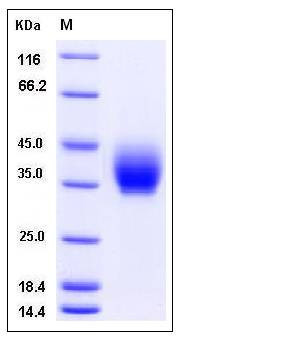Mouse ICOS / AILIM / CD278 Protein (Fc Tag)
AILIM,CCLP,CRP-1,H4,Ly115
- 100ug (NPP3357) Please inquiry
| Catalog Number | P50466-M02H |
|---|---|
| Organism Species | Mouse |
| Host | Human Cells |
| Synonyms | AILIM,CCLP,CRP-1,H4,Ly115 |
| Molecular Weight | The recombinant mouse ICOS/Fc is a disulfide-linked homodimer. The reduced monomer consists of 363 amino acids and has a predicted molecular mass of 40.9 kDa. In SDS-PAGE under reducing conditions, the apparent molecular mass of rmICOS/Fc monomer is approximately 40-45 kDa. |
| predicted N | Glu 21 |
| SDS-PAGE |  |
| Purity | > 97 % as determined by SDS-PAGE |
| Protein Construction | A DNA sequence encoding the mouse ICOS (Q9WVS0) extracellular domain (Met 1-Leu 142) was fused with the Fc region of human IgG1 at the C-terminus. |
| Bio-activity | |
| Research Area | Immunology |Innate Immunity |Monocytes/Macrophages |Co-stimulatory Molecules |
| Formulation | Lyophilized from sterile PBS, pH 7.4 1. Normally 5 % - 8 % trehalose and mannitol are added as protectants before lyophilization. Specific concentrations are included in the hardcopy of COA. |
| Background | Inducible costimulator (ICOS), also called AILIM (activiation-inducible lymphocyte immunomediatory molecule) is a cell-surface receptor, and belongs to the CD28 family of immune costimulatory receptors consisting of CD28, CTLA-4 and PD-1. The interaction of B7-H2/ICOS plays a critical role in Th cell differentiation, T−B cell interactions which is essential for germinal center formation, and humoral immune responses, and as well as the production of cytokine IL-4. In addition, ICOS is more potent in the induction of IL-10 production, a cytokine important for suppressive function of T regulatory cells. The B7-1/B7-2--CD28/CTLA-4 and ICOS-B7RP-1 pathway provides key second signals that can regulate the activation, inhibition and fine-tuning of T-lymphocyte responses. ICOS stimulates both Th1 and Th2 cytokine production but may have a preferential role in Th2 cell development. Moreover, The B7-1/B7-2-CD28/CTLA-4 and ICOS-B7RP-1 pathway has been suggested of being involved in the development of airway inflammation and airway hyperresponsiveness. |
| Reference |
